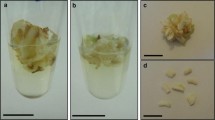Abstract
Young in vitro cultured panicles of maize(Zea mays L.) isolated from plants previously infected under controlled conditions by Sporisorium reilianum (Kühn) Landon and Fullerton, the agent of head smut, were maintained in culture up to the regeneration of healthy plantlets. Production of plants remained low and depended on a synchronization of the date of inoculation with the physiological condition of the mother-plant, which is linked to the season. Use of fungicide throughout the experiment prevented the colonization by the parasite. Such a regeneration takes advantage of a vegetative reversal naturally induced by S. reilianum on certain spikelets. Our method produced regenerants whose characters are different from those of mother-plant: the panicle was always replaced by a fertile ear.
Similar content being viewed by others
References
Beckert M & Pollacsek M (1979) Expression de la variabilityé génétique du mais (Zea mays L.) en différentes conditions de culture de tissus. Ann. Amélior. Plantes 5: 563–581
Beckert M, Pollacsek M & Caenen M (1983) —Etude de la variabilité génétique obtenue chez lemais après callogenèse et régénération de plantes in vitro. Agronomie 3: 9–17
Bhaskaran S, Smith RH & Frederiksen RA (1990) Gibberellin A3 reverts floral primordia to vegetative growth in Sorghum. Plant Sci. 71: 113–118
Bonnier G & Douin R(1911-1935) Flore complète de France, Suisse et Belgique. Tome XII (Poa bulbosa). Librairi Générale de l'Enseignement, Paris
Bruneau R (1985) Régénération in vitro à partir de cals d'embryons immatures de mais. Agronomie 5: 591–596
Casady AJ (1969) Propagation from proliferated sorghum spikelets caused by head smut infection. Crop Sci. 9: 381–382
David C & Margara J (1979) L'évolution en culture in vitro des méristèmes de chou-fleur (Brassica oleracea L. var. botrytis). Comptes Rendus de l'Académie des Sciences, Série III, Sciences de la Vie, Paris 288: 1529–1532
Foster JH & Frederiksen RA (1977) Symptoms of head smut in maize seedlings and evaluation of hybrids and inbreds. Progress Report, Texas Agricultural Experimental Station 3432: January, 1–4
Green CE & Phillips RL (1975) Plant regeneration from tissue culture of maize. Crop Sci. 15: 417–421
Hanna WF (1929) Studies in the physiology and cytology ofUstilago zeae and Sporisorium reilianum. Phytopathology 19: 415–431
Hansen DJ, Bellman SK & Sacher RM (1976) Gibberellic acidcontrolled sex expression of corn tassels. Crop Sci. 16: 371–374
Heller R (1953) Recherches sur la nutrition minérale des tissus végétaux cultivés in vitro. Annales des Sciences Naturelles, Botanique et Biologie Végétale 14: 1–223
Larkin PJ & Scowcroft WR (1981) Somaclonal variation. A novel source of variability from cell cultures for plant improvement. Ther. Appl. Genet. 60: 197–214
Margara J (1978) —Mise au point d'une gamme de milieux pour les conditions de la culture in vitro. Comptes Rendus de l'Académie d'Agriculture de France, 654–661
Margara J (1989) Bases de la multiplication végétative. Les méristèmes et l'organogenèse. INRA Ed. (262pp)
Matheussen AM, Morgan PW & Frederiksen RA (1991) Implication of gibberellins in head smut (Sporisoriumreilianum) of Sorghum bicolor. Plant Physiology 96: 537–544
Morel G (1975) Meristem culture techniques for the long term storage of cultivated plants In: Frankel O H and Hawkes J G (eds), Crop Genetic Resources for Today and Tomorrow Cambridge Univ. Press, 327–332
Nagarathna KC, Shetty SA, Harinarayana G & Shekar Shetty H (1993) Selection for downy mildew resistance of pearl millet. Plant Sci. 90: 53–61
Nelson PM & Rossman EC (1958) Chemical induction of male sterility in inbred maize by use of gibberellins. Science 127: 1500–1501
Nickerson NH (1959) Sustained treatment with gibberellic acid of five different kinds of maize. Annals of the Missouri Botanical Garden 46: 19–37
Pareddy DR (1990) Studies on development and attempted chemical reversion of cultured tassels of two genic male steriles of maize (ms14 and ms24). Maydica 35: 203–208
Pareddy DR & Petolino JF (1990) Somatic embryogenesis and plant regeneration from immature inflorescences of several elite inbreds of maize. Plant Sci. 67: 211–219
Pinard F, Touraud G, Allard C & Piollat MT (1989) La multiplication in vitro du mil (Pennisetum typhoides Stapf et Hubbard) à partir d'inflorescences contaminées par un agent du mildiou: Sclerospora graminicola (Sacc.) Scroet. Comptes Rendus de l'Académie des Sciences. Série III: Sciences de la Vie, Paris 308: 177–182
Potter AA (1914) Head smut of sorghum and maize. J. Agric. Res. 2: 339–378
Vergnet C (1987) Le charbon des inflorescences du mais (Zea mays L.) et du sorgho (Sorghum spp.) à Sphacelotheca reiliana (Kuehn) Clinton: étude de la maladie sur mais, approche de la variabilité de l'agent pathogène. Thèse Docteur-Ingénieur, Ecole Nationale Supérieure de Montpellier, France, (113 p)
Walden DB, Greyson RI, Bommineni VR, Pareddy DR, Sanchez JP, Banasikowska E & Kudirka DT (1989) Maize meristem culture and recovery of mature plants. Maydica 34: 263–275
Wenzler H & Meins F (1987) Persistent changes in the proliferative capacity of maize leaf tissues induced by Ustilago infection. Physiol. Molec. Plant Pathol. 30: 309–319
Author information
Authors and Affiliations
Rights and permissions
About this article
Cite this article
Touraud, G., Bill, L. & Piollat, M. Phyllodied panicles caused by head smut of maize and vegetative multiplication of maize. Plant Cell, Tissue and Organ Culture 50, 19–26 (1997). https://doi.org/10.1023/A:1005887012907
Issue Date:
DOI: https://doi.org/10.1023/A:1005887012907




